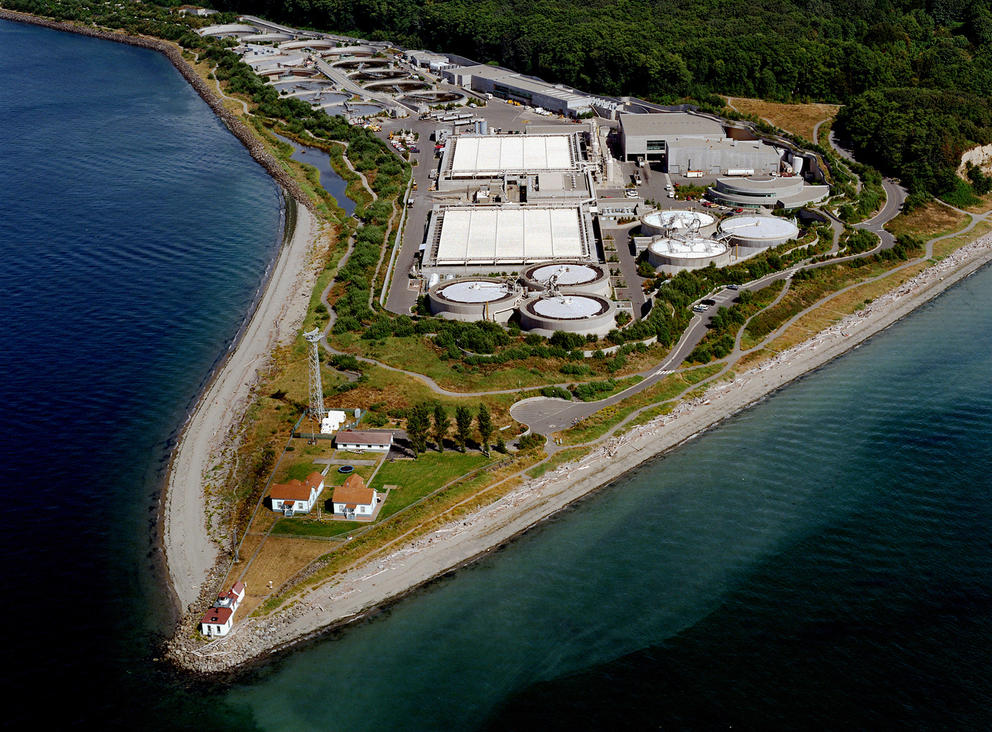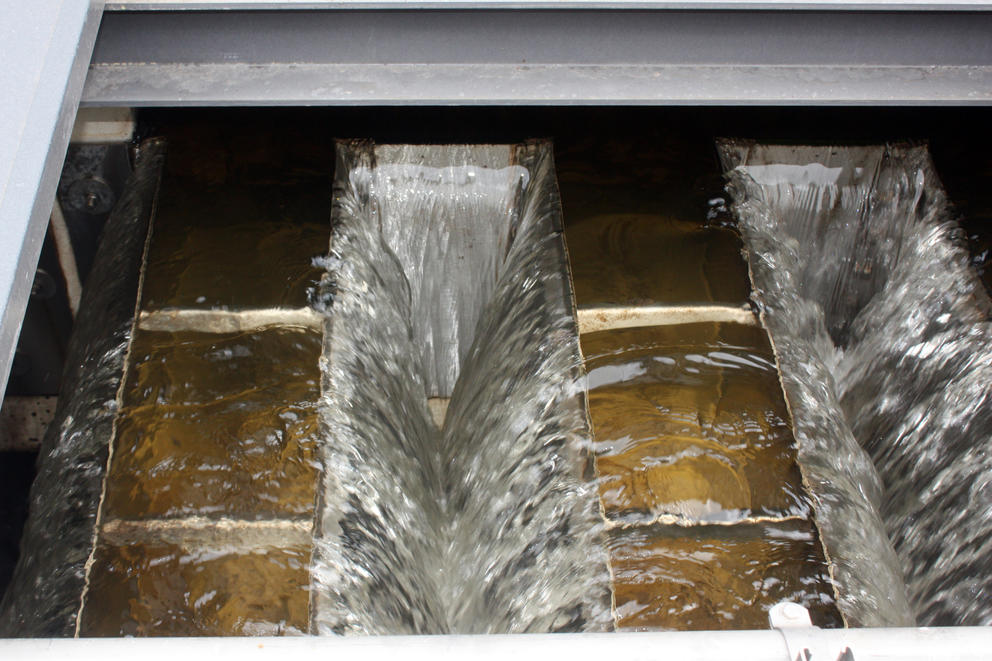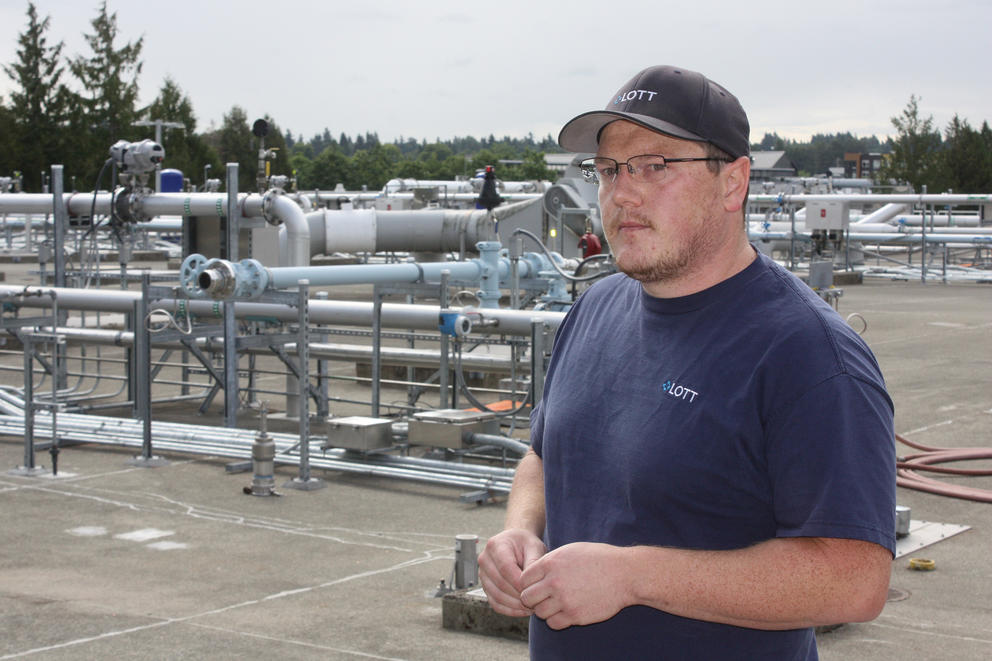The Legislature and the state Ecology Department are considering taking a page from Washington’s new carbon pricing system and applying it to this other kind of pollution. Should Washington put a price on the nutrients flowing from the region’s 58 sewage treatment plants into the Salish Sea? Decisions on whether to pursue this approach will likely be made during the next three years.
Excess nitrogen from nutrients leads to excess algae. This is a problem for Puget Sound because when algae are clumped together into huge mats on or below the surface, they consume oxygen in the water needed by fish such as salmon.
Ninety-one percent of Puget Sound’s nitrogen comes from natural sources in the ocean and river runoff. The remaining 9% flows from sewage treatment plants, agriculture and stormwater runoff from cities, according to the state Ecology Department. And that 9% is enough to tip Puget Sound’s nitrogen content to dangerous-to-fish levels.
“Many parts of Puget Sound have oxygen levels that fall below the concentrations needed for marine life to thrive and are below our state’s water quality criteria,” said a June ecology department report on a potential nutrient trading program among Puget Sound’s sewage plants.
The report concluded: “Without action, water quality will get worse as the area’s population grows. Ecology believes a nutrient credit trading program could lead to faster reductions in nutrient discharges and a quicker recovery of dissolved oxygen to healthy levels in Puget Sound.”
In 2022, the Legislature allocated $350,000 to the Washington Ecology Department in an appropriations bill to research the idea of a nutrient trading program. The June 2023 report is the result of that work so far.
The report recommends further study and asks the Legislature for money to involve the 58 sewage plants in more research on the feasibility of buying and selling nutrient credits from one another.
The state also needs to study how much nitrogen is healthy for Puget Sound, as well as how much inflow should be allowed from individual plants and locations by 2027. That’s when current state permits for the sewage plants will begin to expire and will need to be renewed.
“Before you can do any trading, you have to have numeric limits,” said Jeremy Reiman, an environmental planner for the Ecology Department’s watershed section.
Meanwhile, tribes and other key Puget Sound interests need to be consulted, the report recommended.
At an October 2021 briefing to the House Environment & Energy Committee, Jeff Dickison, a policy analyst with the Squaxin Island Tribe, said sewage treatment plant modifications at LOTT and Shelton have made some, but not enough, improvements in the nutrient situation in the South Sound.
“Even with these incremental improvements, the waters of the Salish Sea have to face extensive loads of nutrients and the noxious conditions that foster the growth of algae,” he said.
Dickison also argued that Joint Base Lewis-McChord be encouraged to participate in similar sewage treatment improvements.
Under the proposed nutrient trading program, a plant with nutrient discharges above its permitted levels could buy credits from another facility with concentrations below that second site’s permitted levels.
With this system, a sewage treatment plant would be working within two limits on nutrients it is allowed to discharge into the Sound. The first would be the level allowed on the permit issued in 2027. The second would be a higher number — the maximum concentration of nutrients allowed before a plant can try to buy credits from another facility.
Matt Valenta, operations manager of the LOTT Water Alliance's sewage treatment plant, explains how nutrients are removed from waste water. The four municipalities that make up LOTT — Lacey, Olympia, Tumwater and Thurston — jointly own and operate the plant through a nonprofit corporation. (John Stang for Crosscut)
In other words, a sewage plant with excessively high nutrient levels in its discharges has to trim its levels to a specific concentration with its own equipment before it can buy credits to reach compliance with its state permit.
“We don’t set limits that we know are unachievable,” said Eleanor Ott, an environmental engineer with the Ecology Department.
One detail yet to be worked out would be whether a plant with excessive nutrient discharges can buy credits from any of the other 57 plants in the Puget Sound region, or whether it will be limited to buying credits solely from plants in the same bay or inlet.
In the meantime, local sewage treatment systems are also making improvements to their systems.The LOTT Clean Water Alliance recently finished roughly $30 million in largely nutrient-related upgrades at its plant on a small peninsula in Olympia that juts into Budd Inlet. LOTT stands for Lacey, Olympia, Tumwater and Thurston County. The public nonprofit alliance handles about 120,000 customers and processes roughly 12 million gallons of wastewater a day, with the ability to peak up to 60 million gallons daily if heavy rains send floods of stormwater through the facility.
When sewage water first hits the LOTT facility, the fluids are screened to remove the solids. Micro-organisms munch on the ammonia in the sewage water, removing the nitrogen in concrete basins with multiple chambers. Automated probes monitor air, nitrogen and other conditions in each chamber, and that information is used to control air flow and shepherd the water from one chamber to the next. That helps keep the micro-organisms happy so they can do the work of removing the nitrogen.
“The micro-organisms are just like us. They need food. They need air,” said Mark Valenta, the plant’s operations manager
Water goes through the chambers three times to remove as much nitrogen as possible, then through further screening and disinfection before it is released into Budd Inlet.
The complicated process didn’t add much to monthly sewage bills, the utility says. This is an important part of researching a potential nutrient trading program.
A question mark on this kind of system improvement is how much it would cost a business or owner on sewage treatment bills.
Tacoma, for example, has two wastewater treatment plants that were not designed for nutrient removal, and either would require significant upgrades and extra land if the state orders it to tackle nitrogen removal. The city is studying nutrient removal measures at both plants, but those plans will depend on what limits the state might impose on Tacoma, wrote Maria Lee, a city spokeswoman, in an email.
An estimate — without knowing how strict any state limits would be — is that potential upgrades could cost $2 billion in Tacoma. Lee wrote that that could translate to big increases in residential bills — from $69 for an average home in 2024 to $303 per month by 2033.
King County’s sewage plants are working on upgrades to keep them below the nitrogen levels required in their current permits. A major concern for the King County wastewater treatment division is what future nitrogen limits will be. That question makes current design work more difficult, wrote Alison Hawkes, a spokeswoman for that division, in an email.
King County is worried that costly infrastructure changes could lead to minimal help on dealing with nitrogen levels.
“Wastewater operations are funded through sewer rates, and avoiding unnecessary rate increases is important in a region already burdened with housing affordability challenges,” Hawkes wrote.
King County is conducting a thorough analysis to better understand how much operations and upgrades would cost over the next decade and how that would impact ratepayers.
“We estimate that sewer rates could escalate to $400 per month with the approach to nutrient reduction envisioned by Ecology,” Hawkes wrote.
The Legislature has provided money to the Association of Washington Cities to do a study on nutrients and some sewage treatment plants. That report is expected to be completed later this year.
Get daily news in your inbox
This newsletter curates some of the most important headlines of the day from Crosscut and other news outlets.





